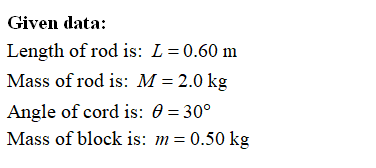The horizontal uniform rod shown below has length 0.60 m and mass 2.0 kg. The left end of the rod is attached to a vertical support by a frictionless hinge that allows the rod to swing up or down. The right end of the rod is supported by a cord that makes an angle of 30° with the rod. A spring scale of negligible mass measures the tension in the cord. A 0.50 kg block is also attached to the right end of the rod. (Source: College Board, AP Physics C Exam) Hinge 2.0 kg- Spring scale 30⁰7 0.60 m (b) Calculate the reading on the spring scale. 4 0.50 kg (a) On the diagram below, draw and label vectors to represent all the forces acting on the rod. Show each force vector originating at its point of application. (c) Calculate the magnitude of the force exerted by the hinge on the rod
The horizontal uniform rod shown below has length 0.60 m and mass 2.0 kg. The left end of the rod is attached to a vertical support by a frictionless hinge that allows the rod to swing up or down. The right end of the rod is supported by a cord that makes an angle of 30° with the rod. A spring scale of negligible mass measures the tension in the cord. A 0.50 kg block is also attached to the right end of the rod. (Source: College Board, AP Physics C Exam) Hinge 2.0 kg- Spring scale 30⁰7 0.60 m (b) Calculate the reading on the spring scale. 4 0.50 kg (a) On the diagram below, draw and label vectors to represent all the forces acting on the rod. Show each force vector originating at its point of application. (c) Calculate the magnitude of the force exerted by the hinge on the rod
College Physics
11th Edition
ISBN:9781305952300
Author:Raymond A. Serway, Chris Vuille
Publisher:Raymond A. Serway, Chris Vuille
Chapter1: Units, Trigonometry. And Vectors
Section: Chapter Questions
Problem 1CQ: Estimate the order of magnitude of the length, in meters, of each of the following; (a) a mouse, (b)...
Related questions
Concept explainers
Rotational Equilibrium And Rotational Dynamics
In physics, the state of balance between the forces and the dynamics of motion is called the equilibrium state. The balance between various forces acting on a system in a rotational motion is called rotational equilibrium or rotational dynamics.
Equilibrium of Forces
The tension created on one body during push or pull is known as force.
Question

Transcribed Image Text:15. The horizontal uniform rod shown below has length 0.60 m and mass 2.0 kg. The left end of the
rod is attached to a vertical support by a frictionless hinge that allows the rod to swing up or
down. The right end of the rod is supported by a cord that makes an angle of 30° with the rod. A
spring scale of negligible mass measures the tension in the cord. A 0.50 kg block is also
attached to the right end of the rod. (Source: College Board, AP Physics C Exam)
Hinge
2.0 kg-
Spring scale
30º
0.60 m
(b) Calculate the reading on the spring scale.
+
0.50 kg
(a) On the diagram below, draw and label vectors to represent all the forces acting on the rod.
Show each force vector originating at its point of application.
(c) Calculate the magnitude of the force exerted by the hinge on the rod
Expert Solution
Step 1

Trending now
This is a popular solution!
Step by step
Solved in 4 steps with 4 images

Knowledge Booster
Learn more about
Need a deep-dive on the concept behind this application? Look no further. Learn more about this topic, physics and related others by exploring similar questions and additional content below.Recommended textbooks for you

College Physics
Physics
ISBN:
9781305952300
Author:
Raymond A. Serway, Chris Vuille
Publisher:
Cengage Learning

University Physics (14th Edition)
Physics
ISBN:
9780133969290
Author:
Hugh D. Young, Roger A. Freedman
Publisher:
PEARSON

Introduction To Quantum Mechanics
Physics
ISBN:
9781107189638
Author:
Griffiths, David J., Schroeter, Darrell F.
Publisher:
Cambridge University Press

College Physics
Physics
ISBN:
9781305952300
Author:
Raymond A. Serway, Chris Vuille
Publisher:
Cengage Learning

University Physics (14th Edition)
Physics
ISBN:
9780133969290
Author:
Hugh D. Young, Roger A. Freedman
Publisher:
PEARSON

Introduction To Quantum Mechanics
Physics
ISBN:
9781107189638
Author:
Griffiths, David J., Schroeter, Darrell F.
Publisher:
Cambridge University Press

Physics for Scientists and Engineers
Physics
ISBN:
9781337553278
Author:
Raymond A. Serway, John W. Jewett
Publisher:
Cengage Learning

Lecture- Tutorials for Introductory Astronomy
Physics
ISBN:
9780321820464
Author:
Edward E. Prather, Tim P. Slater, Jeff P. Adams, Gina Brissenden
Publisher:
Addison-Wesley

College Physics: A Strategic Approach (4th Editio…
Physics
ISBN:
9780134609034
Author:
Randall D. Knight (Professor Emeritus), Brian Jones, Stuart Field
Publisher:
PEARSON